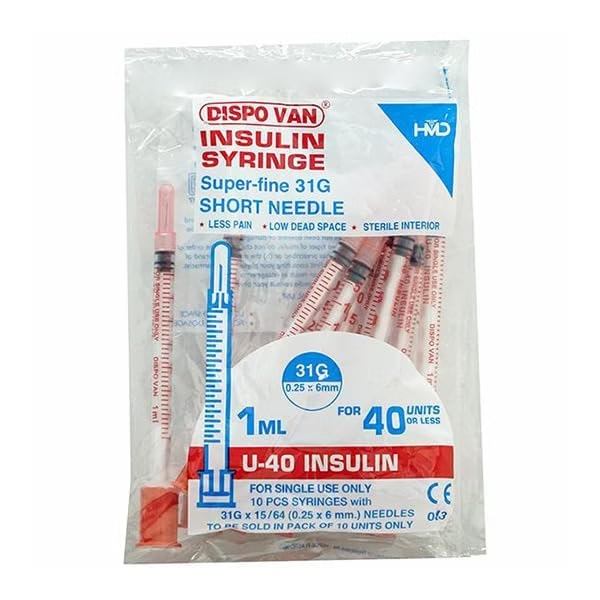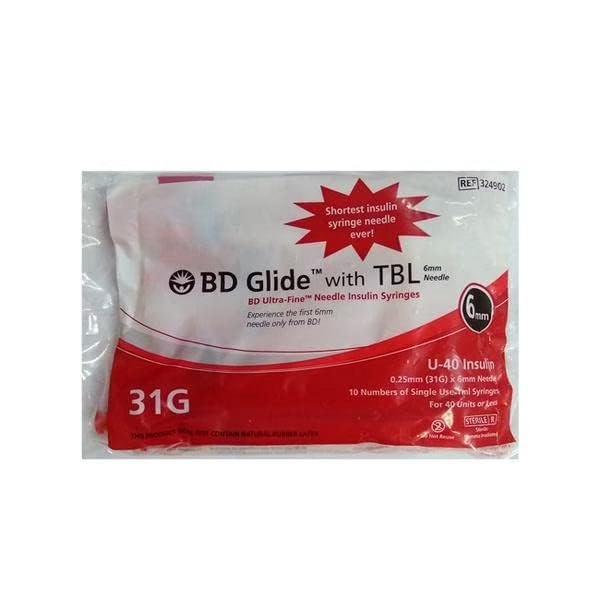Insulin injections are a daily necessity for millions of people with diabetes. Managing blood sugar levels means you need precise dosing and a delivery method you can trust.
An insulin syringe gives you an affordable and straightforward way to inject insulin with accuracy. These syringes aren’t the same as regular medical syringes.
Insulin syringes have smaller needles, so injections hurt less. The barrel uses measurements designed for insulin units, not milliliters.
Most have shorter needles, which work well for subcutaneous shots under the skin. The key is finding the right one for your needs.
When you’re picking an insulin syringe, look at needle length, barrel capacity, and needle gauge. Length usually ranges from 4mm to 12mm.
Shorter needles hurt less, but you’ll need to use the right injection technique. Barrel capacity should fit your typical insulin dose.
Common sizes are 30, 50, or 100 units. Needle gauge matters for comfort—higher numbers mean thinner needles, which most people prefer.
We tried out twelve different insulin syringes to see which ones offer accurate dosing, comfort, and reliable performance for everyday diabetes care.
Best Insulin Syringes
We went through a bunch of insulin syringes to find the best ones for daily diabetes management. Our favorites deliver accuracy, comfort, and quality that actually holds up.
Anmol Dispovan 1ml Insulin Syringes

We like these syringes for folks on a budget who still want reliable insulin delivery. Watch out, though—the quality can be hit or miss.
Pros
- The 31G needle feels almost painless during injections
- Getting 100 syringes in a pack is great value for daily users
- Each syringe comes individually wrapped and sterile
Cons
- Build quality jumps around between batches
- The multicolor look isn’t as professional as clear syringes
- Some units show up with small defects
We found these Anmol syringes handle routine insulin shots just fine. The thin 31G needle goes in smoothly, causing barely any discomfort.
The 1ml size gives you plenty of space for different doses. Measurement marks are easy to read when you’re filling up.
Since the needle’s fixed, there’s no assembly needed. Each one comes in its own sterile wrap, which is handy if you travel or just want to keep things clean.
Quality control is the main downside. Some syringes feel sturdy, others flimsy, and a few have bent needles or fuzzy markings right out of the box.
For the price, they do the job. Just check each syringe before you use it.
Dispovan Insulin Syringes

These single-use syringes give you reliable performance for daily shots, thanks to their ultra-fine needles and low dead space design.
Pros
- 31-gauge needle is super thin and barely hurts
- Low dead space means you waste less insulin
- Sterile packaging keeps things safe
Cons
- Some needles arrive bent, so inspect before using
- The 1ml size might be too small for bigger doses
- Branding is generic, so quality control isn’t always perfect
We found these syringes surprisingly comfortable. The needle slides in without the sharp pinch you get from thicker ones.
Low dead space really stands out—less insulin wasted, which saves money long term. Measurement markings are clear, so drawing up your dose is easy.
Again, quality control is a bit of a gamble. Most syringes are fine, but some have bent needles. Always double-check before you inject.
Anmol BD Ultra Fine Insulin Syringes

We recommend these for diabetics who want comfortable daily injections. Just make sure to check the quantity when your order arrives.
Pros
- Ultra-thin 31G needle is almost painless
- 6mm length matches current safety guidelines
- Tri-bevel tip helps the needle glide in easily
Cons
- Sometimes the pack doesn’t have the advertised number of syringes
- Only works with U-40 insulin, so not for everyone
- Costs more than basic syringes
These BD syringes really do make injections more comfortable. The 31G feels thinner than most, and each shot goes in without much sting.
6mm length is a good fit for most sites. We never had trouble reaching the right layer, and the tri-bevel tip helps a lot.
The latex-free rubber stopper moves smoothly. We always got accurate doses, and the clear barrel markings are easy to read.
Some users complain about missing syringes in the box, so count them when you get your order. Also, these only work with U-40 insulin, so double-check your insulin type.
Dispovan 1ml Insulin Syringes

These syringes work for insulin delivery, but the thin needle means you’ll want a steady hand.
Pros
- Ultra-fine 31-gauge needle cuts down on pain
- Clear markings make dosing simple
- Sterile packaging for each syringe
Cons
- Needle can bend if you’re rough
- Smaller pack size means you’ll reorder more often
- Plastic feels a bit flimsy
We found these syringes get the job done for daily shots. The needle slides in smoothly and doesn’t hurt much if you use the right technique.
Measurement lines stay clear, so you’re not guessing your dose. That’s crucial for blood sugar control.
Each syringe comes in its own pouch, keeping it sterile until you need it. We like not having to worry about contamination.
The needle bends easily if you rush or use too much force. Take it slow and you’ll avoid problems.
Dispovan 1ml U-100 Insulin Syringe

This syringe is a solid pick for anyone who wants an affordable, no-frills option with a fine needle.
Pros
- Ultra-thin 31G needle causes minimal discomfort
- Sterile packaging keeps things safe for single use
- Low price makes it accessible for regular users
Cons
- Only comes in small packs of 10
- Plastic feels less sturdy than higher-end brands
- Barrel markings could be clearer
The Dispovan syringe works reliably for daily insulin injections. The 31G needle goes in almost without feeling it.
Each syringe is individually wrapped and sterile, which gives us peace of mind. The 1ml size is right for most doses up to 100 units.
The plunger moves smoothly. The 6mm needle length suits most people and reaches the right layer under the skin.
The plastic barrel and markings are just okay—easy enough to read in good light, but tricky in dim rooms. The needle hub fits tight, so there’s no wobble during use.
Buying Guide
When we pick insulin syringes, a few factors really matter. The needle gauge and length are at the top of the list.
Needle Size Options
Gauge means how thick the needle is. Higher numbers equal thinner needles, and most insulin syringes use 28-31 gauge.
Length affects how deep your shot goes. Common lengths include:
- 4mm (5/32 inch)
- 6mm (1/4 inch)
- 8mm (5/16 inch)
If you’re thinner, you might need a shorter needle. It’s best to ask your doctor what size fits you.
Syringe Capacity
We really have to match the syringe size to our insulin dose. Common sizes are:
| Capacity | Best For |
|---|---|
| 30 units | Small doses under 30 units |
| 50 units | Medium doses 30-50 units |
| 100 units | Large doses or mixing insulins |
Honestly, smaller syringes just make it easier to get those tiny doses right.
Safety Features
Safety caps snap over the needle after you use it. They help prevent those annoying needle sticks.
Low dead space syringes waste less insulin since there’s barely any empty space inside.
Cost and Insurance
Check if your insurance covers certain syringe types. Generic syringes usually cost less than the big brands.
If you can, buy in bulk—most come in boxes of 100 and it saves money.
Quality Markers
Always look for FDA approval on insulin syringes. Sharp, smooth needles hurt less, which is what we all want.
Frequently Asked Questions
People usually have questions about insulin syringe sizes, needle gauges, and proper disposal methods.
Understanding prescription requirements and how to use syringes correctly makes insulin delivery a lot safer and more effective.
How do I choose the right size of insulin syringe for my needs?
Pick your syringe size based on your usual insulin dose. If you take under 30 units, grab a 0.3 mL (30-unit) syringe.
If you use between 31 and 50 units, go for a 0.5 mL (50-unit) syringe. Over 50 units? Use a 1 mL (100-unit) syringe.
Smaller syringes give you more accurate measurements for low doses. The markings are bigger and easier to read, which is honestly a relief.
What is the difference between U-100 and U-40 insulin syringes?
U-100 syringes are for U-100 insulin (100 units per milliliter). U-40 syringes are for U-40 insulin (40 units per milliliter).
Most insulin in the US is U-100. Using the wrong syringe? That can lead to dangerous mistakes.
Always match your syringe to your insulin’s concentration. The packaging will tell you if it’s for U-100 or U-40—just double-check before using.
Can insulin syringes be purchased without a prescription, and if so, where?
In most U.S. states, you can buy insulin syringes without a prescription. Pharmacies like CVS, Walgreens, and Walmart usually sell them over the counter.
Some states do require a prescription, though. It’s worth checking your local laws before heading to the pharmacy.
You can also buy syringes online, no prescription needed, from medical supply or pharmacy websites.
How do I determine the correct needle gauge for my insulin injections?
Most folks use 28 to 31 gauge needles for insulin. The higher the gauge, the thinner the needle—and honestly, thinner needles hurt less.
Needle length depends on your body type and where you inject. Most people use 4mm to 8mm for subcutaneous shots.
Your healthcare provider can help you pick the best size. Think about your comfort and how you inject when deciding.
Are there any guidelines for safely disposing of used insulin syringes?
Always put used syringes in FDA-approved sharps containers. These are puncture-resistant and made for medical waste.
Never toss syringes in regular trash or recycling. That’s just not safe for anyone handling the garbage.
Many pharmacies and hospitals will take full sharps containers. Some communities even run special collection programs for medical waste.
What steps should I follow to ensure I’m using insulin syringes correctly?
First things first—wash your hands well before you even touch syringes or insulin. If your healthcare provider suggests it, clean the injection site with alcohol too.
Take a good look at your insulin. If you spot clumps, crystals, or any weird color, don’t use it. For cloudy insulin, just roll it gently between your palms to mix it up—no need to shake.
When you’re ready, inject at a 90-degree angle into the subcutaneous tissue. Keep rotating your injection sites so you don’t end up with sore spots or mess with absorption.


